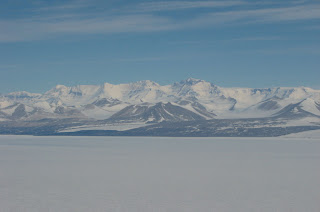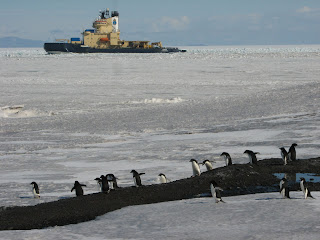It seemed that our team wasn’t going to be able to leave
Christchurch at least till Jan 05! Bruce, my boss, gave the ‘go ahead’ for Liz and myself to make a reconnaissance trip to
Taylor Valley, which was Liz’s area for field work. She was studying the young volcanic cones that were similar in age to
Mt. Erebus and associated volcanoes.
 Liz fixed up a schedule with Helo Ops and we were slated to fly out of McMurdo a little after noon. We picked up backpacks from our ‘equipment cage’ from the Berg Field Center (BFC), had an early lunch, got another packed lunch to have when out in the valleys and reported at the helicopter terminal around 11:30 am. There, Gifford the Helo coordinator gave us a briefing on safety and after selecting appropriate sized helmets we were led to the A-star helicopter where we met our pilot Dustin.
Liz fixed up a schedule with Helo Ops and we were slated to fly out of McMurdo a little after noon. We picked up backpacks from our ‘equipment cage’ from the Berg Field Center (BFC), had an early lunch, got another packed lunch to have when out in the valleys and reported at the helicopter terminal around 11:30 am. There, Gifford the Helo coordinator gave us a briefing on safety and after selecting appropriate sized helmets we were led to the A-star helicopter where we met our pilot Dustin.
I had never been in a helicopter before and boy, I was excited! Liz let me have the front seat next to the pilot, which was sweet. Dustin asked me to relax and said it would feel just like an elevator as we lift off and then it isn’t any different than being in the front seat of a car! Yes, a car without wheels, but with two rotors that could fly! I was expecting it to be a noisy machine to travel in but, the French-made helicopter didn’t make much more than a loud roar and after connecting the headset in the helmet we were able to converse quite comfortably.
Hobbs Glacier and Royal Society Range from the helicopter (helo)
As we left McMurdo we could easily look out north and see the Oden cutting its channel through the ice followed a few miles behind by the Polar Sea widening the channel and soon after the edge of the sea-ice giving way to the deep blue ocean. But we were heading west, flying over the sea-ice a little more than 50 miles to Taylor Valley. Dustin had been flying for more than twenty years and had been in Antarctica for the past few summers. He had a remarkable knowledge of the land and ice around McMurdo and we had a wonderful flight as we learnt many a thing about the ice, glaciers and mountains that we passed.
Bower's Piedmont Glacier from the helo.
Taylor Valley is about 5 miles across and almost 50 miles long running approximately E-W. We landed on the southern side of Talyor Valley about half-way in the valley, near the Solas glacier right on one of the eroded volcanic cones. Taylor Glacier and Lake Bonney lay ahead and below us. The Solas is one of many smaller glaciers that flow down the sides of the valley. They are thick tongues of ice formed along the saddles of the mountains that separate one valley from another.
Raised features on the sea-ice of smooth, blue ice resemble dunes.
We had a beautiful warm day to be out in the valleys and a few hours work later, we heard the roar of Dustin’s helicopter as it approached us and soon it was time to head back to town. It was an amazing day and a truly unforgettable one for me.

The Strand moraines obstruct the flow of the Bower's Piedmont Glacier. Flying over the 5 mile wide Ferrar Glacier!
Flying over the 5 mile wide Ferrar Glacier! A glacier hangs over the Ferrar valley from the Kukri Hills.
A glacier hangs over the Ferrar valley from the Kukri Hills. Looking west into Taylor Valley. From front: Lake Bonney, Taylor Glacier, Ferrar Dolerites (dark bands).
Looking west into Taylor Valley. From front: Lake Bonney, Taylor Glacier, Ferrar Dolerites (dark bands). A dolerite dike intruding granite in Taylor Valley is subject to the erosive power of wind.
A dolerite dike intruding granite in Taylor Valley is subject to the erosive power of wind. The broken fragments of dolerite are sculpted by wind to form beautiful ventifacts with smooth faces.
The broken fragments of dolerite are sculpted by wind to form beautiful ventifacts with smooth faces.


 Adélies are the most common and smallest of Antarctic Penguins and were named so in 1830 by French explorer
Adélies are the most common and smallest of Antarctic Penguins and were named so in 1830 by French explorer 









































.jpg)